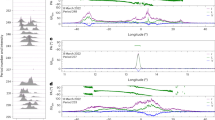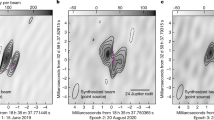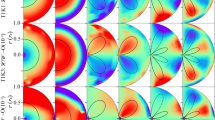Abstract
SEVERAL months have passed since the publication of the discovery of pulsars1 and some tens of papers on this subject have appeared2. So far, however, not enough attention has been paid to the mechanism of radiation. The radio emission from pulsars must come from a low-density plasma atmosphere around the object—a medium which has well known physical properties. This means that the requirements following from an analysis of the radiation mechanism are important in choosing models of pulsars. From this point of view, we have always believed that the most probable pulsar model is a pulsating white dwarf. There is far more radiating plasma in such a model than in a neutron star, and a mechanism for the radiation is clearly seen—shock waves propagating through the atmosphere are responsible for the short pulses of radio emission. It is also evident that in the absence of a stellar magnetic field, radial pulsations of the star lead to non-polarized radiation. The observations of strong polarization3 therefore impelled us to consider models of pulsating magnetic white dwarfs. The assumption that some white dwarfs have a rather strong magnetic field is natural enough and, as far as we know, meets no difficulties. On the other hand, even comparatively small fields (H∼10–100 oersted) have radical effects on the movements of particles and the propagation of waves in a stellar atmosphere. In particular, the “stellar wind” from a magnetic star can come from the polar regions. What is more, in the atmosphere of pulsating magnetic stars acceleration of particles must occur. When the field is regular, some acceleration will certainly take place as a result of magnetic pumping4. If there are also irregular fields—rather probable in this case—cumulative acceleration mechanism may also be effective5. The accelerated particles will fill the radiation belts of the star and come directly outwards from the polar regions to form two streams (for a dipole field). The particles will also be “poured” out of the radiation belts in subpolar regions.
This is a preview of subscription content, access via your institution
Access options
Subscribe to this journal
Receive 51 print issues and online access
$199.00 per year
only $3.90 per issue
Buy this article
- Purchase on SpringerLink
- Instant access to full article PDF
Prices may be subject to local taxes which are calculated during checkout
Similar content being viewed by others
References
Hewish, A., Bell, S. J., Pilkington, J. D. H., Scott, P. F., and Collins, R. A., Nature, 217, 709 (1968).
Maran, S. P., and Cameron, A. G. W., Pulsars (June 1968).
Lyne, A., and Smith, F. G., Nature, 218, 124 (1968).
Alfven, H., and Fälthammar, C. G., Cosmical Electrodynamics (Oxford, 1963).
Syrovatskii, S. I., JETP, 50, 1133 (1966); Astron. J. USSR, 43, 340 (1966).
Pilkington, J. D. H., Hewish, A., Bell, S. J., and Cole, T. W., Nature, 218, 126 (1968).
Ginzburg, V. L., and Syrovatskii, S. I., Origin of Cosmic Rays (Pergamon Press, 1964).
Rosenbluth, M. N., and Post, R. F., Phys. Fluids, 8, 547 (1965).
Zheleznyakov, V. V., JETP, 51, 570 (1966); Astron. J. USSR, 44, 42 (1967).
Zeldovich, Ya. B., Astron. J. USSR (in the press).
Eroukhimov, L. M., and Pisareva, V. V., Astron. Circ. USSR (in the press).
Author information
Authors and Affiliations
Rights and permissions
About this article
Cite this article
GINZBURG, V., ZHELEZNYAKOV, V. & ZIATSEV, V. Magnetic Models of Pulsars. Nature 220, 355–356 (1968). https://doi.org/10.1038/220355a0
Received:
Published:
Issue date:
DOI: https://doi.org/10.1038/220355a0
This article is cited by
-
Bouncing-core Theory of Pulsars
Nature (1970)
-
Are pulsars single stars?
Astrophysics and Space Science (1970)
-
Magnetic Models of Pulsars and Rotating Neutron Stars
Nature (1969)
-
Superfluidity and superconductivity in the universe
Journal of Statistical Physics (1969)
-
Coherent mechanisms of radio emission and magnetic models of pulsars
Astrophysics and Space Science (1969)



